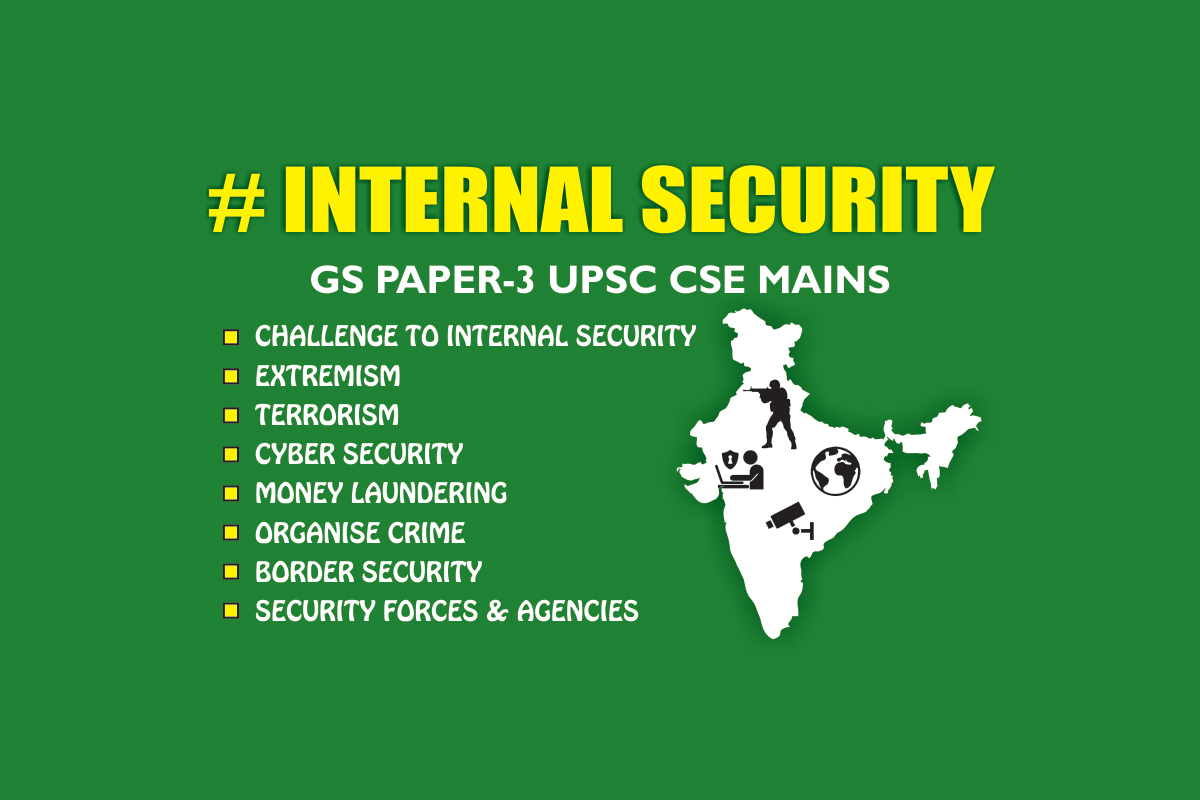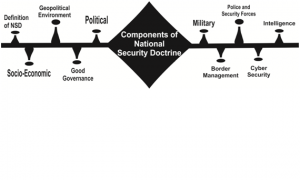-
National Security Doctrine for India: Need of the hour
The National Security Doctrine means the stated principle of government policy in different aspects on national security, like terrorist attack, armed insurgency, and military. The document would guide the government on security matters at both strategic and operational level. It would guide the government on how to react to different security problems.
1.1 Why India needs a National Security Doctrine (NSD)
In the aftermath of recent attacks such as Pathankot, Nagrota etc., the experts are of views that there is an imminent need for National Security Doctrine. The absence of such a doctrine has created the following problems:
- There is no political consensus in the country regarding national security issues. The government policy keeps on changing with regard to change in the government. There is lack of agreement on threats from Pakistan, Maoism, insurgency, and so on.
- We have suffered in coordinating the efforts of various government departments to formulate and address the issues of national security. There is no common understanding among various segments of the government on what national security constitutes.
- In absence of a coherent strategy, the government response to any security issue has remained ad hoc and partial, and thus largely unsuccessful. For example, NSG was called in Pathankot incidence even when an army’s company was stationed there.
- After a national security incident, e.g. a bomb attack, finger is pointed at various agencies, but fixing accountability becomes very difficult because of a lack of understanding on the responsibility of various agencies during a security threat.
- There has been no effort to define our enemy, the sources of trouble, the instruments and the administrative and political skills required to our tackle our enemy.
- Since there has been no internal security doctrine, there has been little calibration of foreign policy with national security efforts. For example, we don’t know what kind of foreign policy with Pakistan will decrease terrorism threat.
- Moreover, we don’t know what demands are to be made from the citizens in case of a national security threat.
- Significance of NSD
A National Security doctrine will play a crucial role in internal security in the following ways:
- This would help in prompt and relevant decision making as the decisions will be guided by national security strategy enshrined in the doctrine.This would result in consistent security response at the time of insurgences.
- It would help in maintaining the proper co-ordination among security establishments at both Central and State level, and avoid terror attacks which occurred even when intelligence agencies have inputs but due to lack of co-ordination fail to prevent the attacks.
- This would also make the security establishments more accountable in case of any failure to combat the terror attack.
- Moreover, prompt and successful handling of such attacks would ensure peace, progress and development in the country.
1.3 What should be the constituents of the NSD?
The dignitaries and learned people from various quarters have commented on the constituents of the national security doctrine, the most important being ex Director General of Border Security Force (BSF), Mr. Prakash Singh. According to their views and given the complex and varied nature of threats, India requires a comprehensive internal security strategy involving following components:-
- Definition: It should define the objectives of National Security clearly and the capabilities required dealing with them.
- Geopolitical Environment: It should contain an appreciation of the Geopolitical environment and its impact on internal security.
- Political: The political component includes a will to take threats head on, a multi-layered grievance redressal system, constitutional safeguards and good governance, which in turn demands reforms in administration, the electoral system and criminal justice system. The doctrine should understand the nature of challenges to internal security and the methodology to deal with them The institutions of governance and state structures should be strong enough to deal with internal conflicts in a coordinated way. Secessionist forces (those demanding a different nation) should be dealt with an iron hand; we need to look for a constitutional solution for separatist elements and then deal accordingly with them. Winning back and sustaining the confidence of alienated communities through political means is crucial for the long-run.
- Socio-Economic: The Government would need to understand the socio-economic grievances behind the internal security threats. For example, the main reason behind naxalism has been economic exploitation and displacement of tribal people. The government should try to address these socio economic causative factors in order to eliminate these security threats. Inequity and deprivation breed resentment and alienation whereas a thriving economy, which gives hope and opportunity to all, is more likely to defeat extremist movements than any other strategy. There is an urgent need to adopt an inclusive development model that allows people to contribute to and benefit from this economic growth.The social element should take into consideration the support of the population in countering internal security threats. Without the eyes, ears and intuition of the general public, it is difficult to identify terrorists who blend seamlessly into the environment in which they live and operate. People can contribute as informers, witnesses, and rescuers. A strong security consciousness needs to be created. It is also important to engage and take the help of civil society organisations like self-help groups, non-governmental organisations, think tanks and the media in addressing internal security threats.
- Governance: Bad governance and corruption in remote areas has been a main reason for internal security issues. The doctrine should identify such mal- administered areas and try to implement good governance there so that aspirations of the people over there are fulfilled.The Centre State co-ordination should be strengthened. The doctrine should elaborate different types of internal security threats and the individual role of Centre and States in each of them. It should help in coordination in all areas from intelligence to operations.
- Military: Within the military component, three broad measures are suggested: prevention, deterrence and rehabilitation. A comprehensive database of terror groups must be drawn up, detailing their ideology, organizational set-up, leadership, goals, modus operandi, training systems, support network, sponsors, weapon systems, and funding sources. It is necessary to employ covert operations, but they should be restricted to eliminating terrorist leadership and bases abroad and within India.
- Police and Security Forces: Sometimes excess of security forces leads to augmentation on internal security issues. Developing specialized counter-terrorism forces, strengthening the local police and a strong legal framework are some of the deterrence measures that are required. The mantra is, right force for the right situation. While the Central Reserve Police Force (CRPF), the nodal counter-insurgency force, requires restructuring and value additions, the National Security Guard (NSG), India’s primary strike force for counter-terrorist operations, must be provided with the necessary wherewithal to respond swiftly to terrorist attacks. Significant improvement is called for in the training of state police forces, who are the first responders. At the same time, it is important to have a comprehensive legal framework against terrorism that conforms to the rule of law and human rights standards. The doctrine needs to address the issues of police sensitivity, human rights violations and police reforms.
- Intelligence: Intelligence agencies are often made scapegoat for any internal security problem. To avoid this, the doctrine should clearly deal with the coordination of intelligence agencies among themselves and with the agencies of the foreign countries. They should be given both defensive and offensive capabilities, depending on the internal security situation. Intelligence gathering in India, especially the preventive aspects of intelligence, needs substantial improvement.
- Border Management: Porous borders have created issues of infiltration, illegal immigration, smuggling of weapons, and militants taking shelter in neighborhood countries. Therefore, the doctrine should guide on guarding our borders to prevent the above mentioned problems. Vigilance along land, coastal and maritime borders needs to be substantially enhanced, including through the use of hi-tech surveillance devices. Additionally border management could be more efficiently coordinated among various central and state agencies that operate along the country’s borders.
- Cyber Security: The modern day warfare is going in the cyber space, with elements like cyber war, cyber terrorism, cyber espionage and so on. Thus the doctrine needs to strengthen our capabilities to adequately deal with them.
It should be noted out that all the above components of a comprehensive internal security strategy are not mutually exclusive but are interlinked. At times, the required measures may conflict with each other. But unless these components are wielded in exact proportions as the situation demands, it would difficult to address threats. Going too far in one direction could be counter-productive. Striking the right balance is key to a comprehensive strategy.


